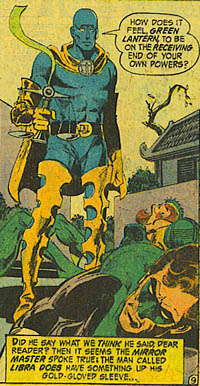Comic Book Confidential: JLA ‘74
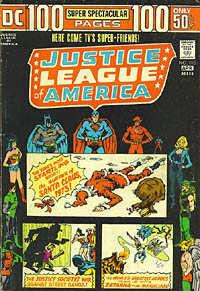 With Free Comic Book Day coming up this weekend I thought it was a good time to open up the Retrorama Newsstand and peer into the past. I’m not big into crowds and don’t have kids so I usually steer clear of my local comic book shop on the first Saturday of May but if you don’t want to spend any cash or are trying to introduce someone to the world of comics, this is the event for you!
With Free Comic Book Day coming up this weekend I thought it was a good time to open up the Retrorama Newsstand and peer into the past. I’m not big into crowds and don’t have kids so I usually steer clear of my local comic book shop on the first Saturday of May but if you don’t want to spend any cash or are trying to introduce someone to the world of comics, this is the event for you!
1974 was a great year to be reading DC Comics and if you were a fan of the Justice League of America like I was it was a double bonus. Even if you were only a precursory reader of comics, it was hard not to like this smorgasbord of superheroes whose members included Superman, Batman, Wonder Woman, Flash, Green Lantern, Hawkman, Atom and many more. The JLA was one of several comic book titles, including Batman, Flash, World’s Finest, Shazam, and Brave and the Bold, that DC gave the 100 Page Super Spectacular treatment to in 1974. This deluxe format gave readers a whopping one hundred pages of their favorite heroes and also contained text pages, pin ups, crosswords, and puzzles. This sixty cent bargain was a pretty sweet deal for kids on an allowance like I was.
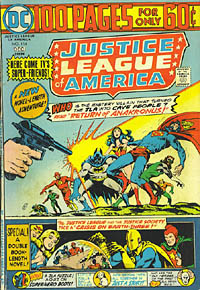 The 100 Page Super Spectacular was a gimmick DC had started a few years earlier in 1971 as a follow up to their popular 80-Page Giant books. Originally these were one shot issues with no correlation to any regular ongoing titles. The books were composed entirely of reprint stories but gave many younger readers like me their first taste of Golden Age stories from the 1930’s and also allowed DC to utilize the backlog they had inherited when they purchased other companies such as Fawcett and Quality. Many Golden Age heroes like Johnny Quick, Air Wave, The Spider, and Kid Eternity made their first Silver Age appearances in these pages. As the old saying goes, they may have been reprints but all of these stories were new to me!
The 100 Page Super Spectacular was a gimmick DC had started a few years earlier in 1971 as a follow up to their popular 80-Page Giant books. Originally these were one shot issues with no correlation to any regular ongoing titles. The books were composed entirely of reprint stories but gave many younger readers like me their first taste of Golden Age stories from the 1930’s and also allowed DC to utilize the backlog they had inherited when they purchased other companies such as Fawcett and Quality. Many Golden Age heroes like Johnny Quick, Air Wave, The Spider, and Kid Eternity made their first Silver Age appearances in these pages. As the old saying goes, they may have been reprints but all of these stories were new to me!
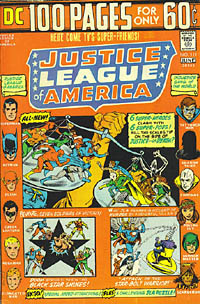 After the warm sales reception the first series of Spectaculars received, DC made a few alterations for the next batch. This format was now incorporated into the regular runs of some of their most popular series and the lead off in each issue would be a brand new tale. The remaining material would continue to be the economical reprints but it was more carefully selected to reflect the theme of the particular title. For the Justice League of America, this usually meant a total of three or four stories in each issue. Two of these would feature the JLA, one new story and a classic reprint from the early years of the title, a Golden Age piece featuring the Justice Society of America or The Seven Soldiers of Victory, and a sometimes solo tale featuring a Golden Age character.
After the warm sales reception the first series of Spectaculars received, DC made a few alterations for the next batch. This format was now incorporated into the regular runs of some of their most popular series and the lead off in each issue would be a brand new tale. The remaining material would continue to be the economical reprints but it was more carefully selected to reflect the theme of the particular title. For the Justice League of America, this usually meant a total of three or four stories in each issue. Two of these would feature the JLA, one new story and a classic reprint from the early years of the title, a Golden Age piece featuring the Justice Society of America or The Seven Soldiers of Victory, and a sometimes solo tale featuring a Golden Age character.
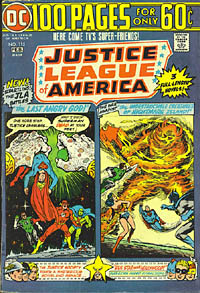 From the spring of 1974 until a little over a year later in 1975, DC Comics published seven bi-monthly issues of Justice League of America; #’s 110-116, in the 100 page format. While they could have easily just tossed in second rate stories for the new material, and there were a couple of stinkers, most of these were above average tales. Issue #111 for example saw the reformation of the Injustice League under the leadership of a new villain called Libra. The Tattooed Man, Shadow Thief, Chronos, Poison Ivy, Mirror Master, and The Scarecrow were a pretty strange roster but it was still a lot of villains for your money! At the conclusion of the story, Libra has double crossed his teammates and revealed his plan to steal half of the powers of the JLA members and eventually the universe. Like most power mad bad guys though, he overloads himself in the process and his atoms are scattered throughout the galaxy –
From the spring of 1974 until a little over a year later in 1975, DC Comics published seven bi-monthly issues of Justice League of America; #’s 110-116, in the 100 page format. While they could have easily just tossed in second rate stories for the new material, and there were a couple of stinkers, most of these were above average tales. Issue #111 for example saw the reformation of the Injustice League under the leadership of a new villain called Libra. The Tattooed Man, Shadow Thief, Chronos, Poison Ivy, Mirror Master, and The Scarecrow were a pretty strange roster but it was still a lot of villains for your money! At the conclusion of the story, Libra has double crossed his teammates and revealed his plan to steal half of the powers of the JLA members and eventually the universe. Like most power mad bad guys though, he overloads himself in the process and his atoms are scattered throughout the galaxy –  taking half of the hero’s powers with them! It was extremely unusual for comic book tales to span multiple issues in these days but two months later the League had to revive the android Amazo to reclaim their lost abilities in another excellent tale. Libra was left in disembodied limbo after issue #111, presumably never to be seen again but advance solicits for DC’s 2008 mega-series, Final Crisis, indicate it just took him 24 years to pull himself back together!
taking half of the hero’s powers with them! It was extremely unusual for comic book tales to span multiple issues in these days but two months later the League had to revive the android Amazo to reclaim their lost abilities in another excellent tale. Libra was left in disembodied limbo after issue #111, presumably never to be seen again but advance solicits for DC’s 2008 mega-series, Final Crisis, indicate it just took him 24 years to pull himself back together!
Most of the other issues during this time period at least featured notable events even if some of the stories were not as interesting as the end result. In issue #110 (which features a great cover of Santa Clause lying dead face down in the snow), John Stewart, the African-American alternate Green Lantern, makes his second comic book appearance and has his first meeting with the JLA. During the annual team up with the Justice Society of America in issue #113, the first Silver Age appearance of the Sandman’s sidekick Sandy the Golden Boy is marked with tragedy. Due to a 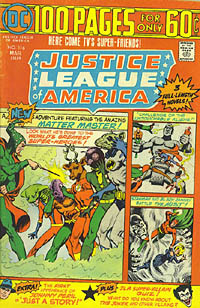 miscalculation with an experimental silicon ray, Sandy had been transformed into a monster and had been in stasis for many years. Thankfully he had at least become rational by the end of the story and would later be returned to human form in time to form the modern version of the Justice Society. Founding member J’onn J’onzz, the Martian Man hunter, made a guest appearance in issue #115 and original JLA mascot Snapper Carr turned up in #114 for the first time since he had betrayed the team to the Joker years earlier. Finally in issue #116, the villain the Matter Master inadvertently created a new superhero, The Golden Eagle, who would play an important role in the Teen Titans and Hawkman series a few decades later.
miscalculation with an experimental silicon ray, Sandy had been transformed into a monster and had been in stasis for many years. Thankfully he had at least become rational by the end of the story and would later be returned to human form in time to form the modern version of the Justice Society. Founding member J’onn J’onzz, the Martian Man hunter, made a guest appearance in issue #115 and original JLA mascot Snapper Carr turned up in #114 for the first time since he had betrayed the team to the Joker years earlier. Finally in issue #116, the villain the Matter Master inadvertently created a new superhero, The Golden Eagle, who would play an important role in the Teen Titans and Hawkman series a few decades later.
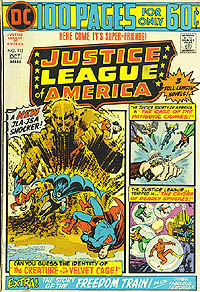 With issue number 117, which incidentally returned Hawkman to membership in the Justice League, the title reverted back to a standard page count and 25 cent cover price. For several years following this, the book seemed much weaker. The stories were mostly forgettable and the back up reprints were sorely missed. It would take over twenty issues before the JLA comic book went through another resurgence of quality but it would never truly equal the 100 Page Super Spectacular run again.
With issue number 117, which incidentally returned Hawkman to membership in the Justice League, the title reverted back to a standard page count and 25 cent cover price. For several years following this, the book seemed much weaker. The stories were mostly forgettable and the back up reprints were sorely missed. It would take over twenty issues before the JLA comic book went through another resurgence of quality but it would never truly equal the 100 Page Super Spectacular run again.
